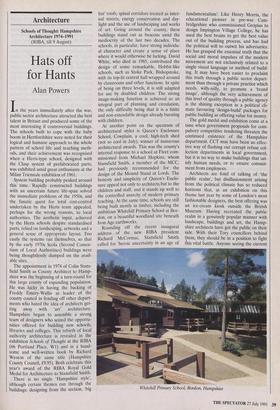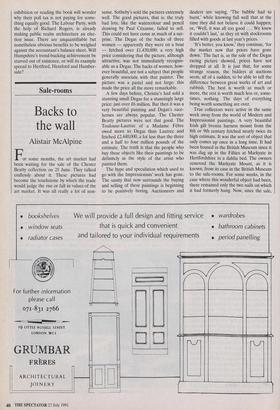Architecture
Schools of Thought: Hampshire Architecture 1974-1991 (RIBA, till 9 August)
Hats off for Hants
Alan Powers
In the years immediately after the war, public sector architecture attracted the best talent in Britain and produced some of the most interesting if controversial buildings. , The schools built to cope with the baby boom in Hertfordshire were noted for their logical and humane approach to the whole pattern of school life and teaching meth- ods, and their achievement was recognised when a Herts-type school, designed with the Clasp system of prefabricated parts, was exhibited amid great enthusiasm at the Milan Triennale exhibition of 1961.
System building probably peaked around this time. Rapidly constructed buildings with an uncertain future life-span solved the immediate problems of the 1950s, and the fanatic quest for total cost-control undertaken by the Herts team appealed, perhaps for the wrong reasons, to local authorities. The aesthetic input, achieved by the Herts schools despite standardised parts, relied on landscaping, artworks and a general sense of appropriate layout. Too easily the systems ran themselves, so that by the early 1970s Scola (Second Consor- tium of Local Authorities) buildings were being thoughtlessly dumped on the avail- able sites.
The appointment in 1974 of Colin Stans- field Smith as County Architect to Hamp- shire was the beginning of a turn-round for this large county of expanding population. He was lucky in having the backing of Freddy Emery-Wallis as leader of the county council in fending off other depart- ments who hated the idea of architects get- ting away with 'art' architecture. Hampshire began to assemble a strong team of designers who seized the opportu- nities offered for building new schools, libraries and colleges, This rebirth of local authority architecture is revealed in the exhibition Schools of Thought at the RIBA (66 Portland Place, W1) and in a hand- some and well-written hook by Richard Weston of the same title (Hampshire County Council, £9.95). Both celebrate this year's award of the RIBA Royal Gold Medal for Architecture to Stansfield Smith.
There is no single 'Hampshire style', although certain themes run through the buildings: designing from the section, 'big hat' roofs, spinal corridors treated as inter- nal streets, energy conservation and day- light and the use of landscaping and works of art. Going around the county, these buildings stand out as beacons amid the mediocrity of the last two decades. The schools, in particular, have strong individu- al character and create a sense of place where it would otherwise be lacking. David White, who died in 1985, contributed the design of some remarkable, Hobbit-like schools, such as Stoke Park, Bishopstoke, with its top-lit central hall wrapped around by classrooms and other functions. In spite of being on three levels, it is still adapted for use by disabled children. The strong image-making function is achieved as an integral part of planning and circulation, the only difficulty being that it is a finite and non-extendable design already bursting with children.
At another point on the spectrum of architectural styles is Queen's Enclosure School, Cowplain, a cool, high-tech shed (not so cool in July), winner of numerous architectural awards. This was the county's internal response to a school at Fleet com- missioned from Michael Hopkins, whom
• Stansfield Smith, a member of the MCC, had previously recommended for the design of the Mound Stand at Lords. The honesty and simplicity of Queen's Enclo- sure appeal not only to architects but to the children and staff, and it stands up well to the controlled anarchy of modern primary teaching. At the same time, schools are still being built mostly in timber, including the ambitious Whitehill Primary School at Bor- don, on a beautiful woodland site beneath Iron Age earthworks. Rounding off the recent inaugural address of the new RIBA president Richard McCormac, Stansfield Smith called for 'heroic uncertainty in an age of fundamentalism'. Like Henry Morris, the educational pioneer in pre-war Cam- bridgeshire who commissioned Gropius to design Impington Village College, he has used the best brains to get the best value out of the building process, and has had the political will to outwit his adversaries. He has grasped the essential truth that the social and moral impulses of the modern movement are not exclusively related to a single visual language or method of build- ing. It may have been easier to proclaim this truth through a public sector depart- ment than through a private practice which needs, willy-nilly, to promote a 'brand image', although the very achievement of this level of quality through a public agency is the shining exception in a political cli- mate favouring 'design-build' packages for public building as offering value for money. The gold medal and exhibition come at a time when government proposals for com- pulsory competitive tendering threaten the continued existence of the Hampshire department. CCT may have been an effec- tive way of flushing out corrupt refuse col- lection departments in local government, but it is no way to make buildings that sat- isfy human needs, or to ensure commit- ment from employees.
Architects are fond of talking of 'the public realm', but disillusionment arising from the political climate has so reduced horizons that, at an exhibition on this theme last year by some of London's most fashionable designers, the best offering was an ice-cream kiosk outside the British Museum. Having recreated the public realm in a genuinely popular manner with landscape, buildings and art, the Hamp- shire architects have got the public on their side. With their Tory councillors behind them, they should be in a position to fight this vital battle. Anyone seeing the current Whitehall Primacy School, Bunion, Hampshire exhibition or reading the book will wonder why their poll tax is not paying for some- thing equally good. The Labour Party, with the help of Richard Rogers, is already making public realm architecture an elec- tion issue. There are unquantifiable but nonetheless obvious benefits to be weighed against the accountant's balance sheet. Will Hampshire's trend-bucking achievement be starved out of existence, or will its example spread to Hertford, Hereford and Humber- side?



















































 Previous page
Previous page